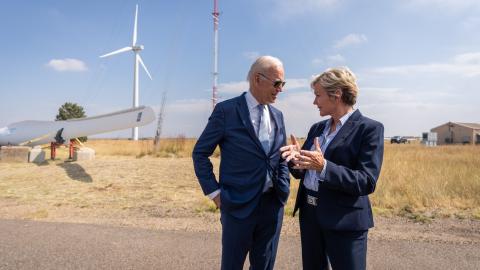The gap between reality and unbridled idealism concerning the nation’s energy policy has reached a crisis level. As consumer energy prices continue to soar, the Biden administration’s erratic departure from sound energy policy is ignored in favor of the White House touting the benefits of “Bidenomics.”
With the fiftieth anniversary of the Arab oil embargo less than a month away, the administration has steered the country away from robust domestic energy production in a way not seen since the Jimmy Carter years. In another Carteresque similarity, President Biden’s approval rating stands at 37%.
Regardless of party, every administration since President Richard Nixon’s — except Mr. Carter’s and Mr. Biden’s — has sought to decrease energy instability, decrease consumer prices, and ensure a stable domestic energy supply. The hallmarks of a rational energy security policy are demonstrated by more economic growth, and administrations that have such a policy are better inoculated from geopolitical tensions.
The availability of affordable energy undergirds the U.S. economy, our prosperity as a country, and our strength as a nation. Energy is the keystone ingredient to all these things, and after raw materials and labor costs, it is the most significant cost factor in everything we buy and use. In other words, it is really important to our daily lives.
The White House’s energy policy owes less to Mr. Biden than to a few key members of his inner circle who see themselves as the global intellectual elite. These senior advisers left little doubt by canceling the Keystone XL pipeline on day one of his presidency.
Championing a rapid transition to all renewable energy, his administration, which promised to govern from the center, quickly departed from that assurance by embracing a whole-of-government approach to climate consciousness that made European progressives blush.
Since then, global inflation and volatile energy costs have forced many nations — including our own — to think pragmatically about their energy supply chains and overall energy security. Undaunted, this administration has continued to push a counterintuitive energy transition via government mandate in every way possible. Bypassing Congress through regulations and executive orders appears to be the Biden administration’s central strategy.
The unitary executive theory, which asserts that Congress cannot limit presidential control of the executive branch because the Constitution sets up a hierarchy in which the president has the most power, was once decried by the left. Yet the president’s advisers seem to have fully embraced the idea. Gone are the days when a frustrated President Ronald Reagan suggested that the “do-nothing” Congress had tied his hands.
Two rules recently proposed by the Environmental Protection Agency would shut down many gas- and coal-fired power plants while placing future strain on the electrical grid by pushing the domestic automobile market to move to electric vehicles.
The power-plant rule would require most gas- and coal-fired plants to reduce their emissions by 90% over the next 10 to 15 years. The intended result is simple: Raise the bar so high that passing means shutting down. Forcibly retiring our power generation facilities without thoroughly examining how base-load energy production will be replaced is a recipe for disaster.
Carbon capture promises to help reduce emissions in a way that makes far more sense. Unfortunately, the first two major projects are already facing the standard anti-infrastructure opposition as seen by oil and gas projects because carbon capture isn’t ideologically pure enough for green advocates.
The EPA’s proposed tailpipe emissions standards are also out of touch with reality. Automobile manufacturers know it but have generally played along because they have likely concluded that the turnover of a new EV fleet means more car sales in the short term. The potential regulation would place strict requirements on tailpipe emissions for light- and medium-duty vehicles, which, if adopted, would effectively force 67% of vehicles to be zero-emission by 2032.
Yet consumers seem unwilling to go electric, even with significant government subsidies. In a recent poll, only 19% said they were seriously interested in purchasing an electric vehicle. EV sales have grown, yet account for only 5.8% of cars sold in the U.S.
Meanwhile, losses at U.S. automobile manufacturers are mounting as unwanted EVs sit in dealer parking lots where the availability of electric vehicle inventories is double that of traditional vehicles.
The EPA’s proposed tailpipe emissions standards would limit consumer choice, raise costs, and increase demand for our overworked electrical grid.
While grid updates have been promised, they are held hostage to the same environmental review process that has thwarted traditional oil and gas infrastructure. New electric projects can take a decade or longer. Power boards are already signaling that consumer demand may force consumers not to use electricity at certain peak times during the day.
Electric vehicles are not the magic bullet the Biden administration claims. A Toyota corporate office memo illustrates significant roadblocks regarding the growing domestic EV market. Toyota notes “three major barriers” to widespread adoption: critical minerals, charging infrastructure, and affordability.
The critical minerals component may be the most important piece of the puzzle. Toyota estimates that “more than 300 new lithium, cobalt, nickel, and graphite mines” will be needed “to meet the expected battery demand by 2035.”
In the memo, Toyota prefers a hybrid electric vehicle model over a pure battery-electric vehicle because the amount of raw materials needed to make one long-range fully electric vehicle is the equivalent of 90 hybrid vehicles.
By picking the best energy sources where they make the most sense, we can reduce our environmental footprint while delivering affordable, clean and reliable energy when and where it is needed.
Innovation and transitions will occur, but not at the rates some in the Biden White House have hoped for. After all, former Vice President Al Gore gave us until 2018 to produce 100% of electricity by renewables. His speech is a reminder that physics and science always outperform political rhetoric.



















